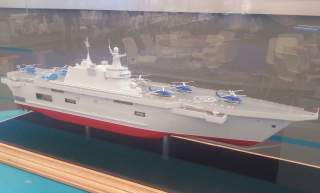Russia Plans to Build New 'Helicopter' Aircraft Carriers
Vital for power projection.
Key point: While helicopter carriers aren't the same as regular aircraft carriers, they still provide mobile air support for ground troops.
For the first time since the 1990s, Russia’s helicopter carriers are coming back.
Russia will begin building two helicopters carriers as of May 2020, according to Russian news agency TASS, citing unnamed sources. And in a slap at the West, the ships will be built in a shipyard in the Crimea, forcibly annexed from Ukraine in 2014, which led to Western sanctions against Russia.
"Two amphibious assault ships, with water displacement of up to 15,000 tons, will for the first time in Russian history be laid down at the Zaliv shipyard in Kerch in 2020," one source said. The first vessel is slated to be delivered before Russia’s current 10-year arms procurement plan ends at the end of 2027.
“The ships will be able to carry over 10 helicopters of various types and will be equipped with a dock-type chamber for landing craft utilities (LTU),” TASS said. How many troops will be carried wasn’t specified, though TASS noted that such ships carry from a few hundred to more than a thousand soldiers.
The U.S. Navy operates eight Wasp-class amphibious assault ships, each about 41,000 tons. They carry almost 2,000 Marines, plus up to a dozen landing craft, 30 M-1 tanks and AAV7A1 amphibious armored vehicles, eight towed 155-millimeter howitzers, and almost a hundred trucks, Humvees and other support vehicles. That ground force is supported by a powerful mixed air unit comprising about 20 to 30 transport and attack helicopters, MV-22 Osprey tilt-rotor aircraft, AV-8B Harrier jets and F-35B short-takeoff and vertical landing (STOVL) stealth fighters.
The Wasps give the United States the capability to land a Marine Expeditionary Unit (essentially a reinforced infantry battalion) by sea or air, backed by armor and air support. Deployed around the world as the centerpiece of Amphibious Ready Groups complete with escort warships, such groups have allowed America to land troops at global hotspots at short notice.
But the Russian vessels seem closer to France’s Mistral-class amphibious assault ships. The 21,000-ton Mistrals accommodate up to 900 troops, 40 Leclerc tanks, 16 transport and attack helicopters, and a few amphibious landing vehicles. France operates three, while Egypt has two.
And therein lies the irony. Russia was supposed to buy two Mistrals: after the Crimean annexation and Western sanctions, the two ships were sold to Egypt to Russia’s intense fury.
“Remember how France denied Moscow Mistrals over Ukraine? Now Russia ‘to make own carriers IN CRIMEA,’” proclaimed the headline on state-owned news site Russia Today.
There may very well be an element of national pride (and giving the West the middle finger) in building its own helicopter carriers. But it also points to a more muscular Russian foreign policy.
In the 1960s, the Soviet Union built two helicopter carriers: the Moskva and Leningrad. These were fleet warships, intended for anti-submarine warfare and equipped with 18 sub-hunting helicopters. These were the closest things that the Soviets had for aircraft carriers until the Kiev-class vessels of the 1970s and 1980s.
The new Russian amphibious assault ships suggest a more American-style doctrine of amphibious expeditionary forces that Moscow can maintain off hotspots such as Syria. If so, “send in the Marines” may become as much a Russian phrase as American.
Michael Peck is a contributing writer for the National Interest. He can be found on Twitter and Facebook. This first appeared in September 2019.
Image: Wikimedia.

